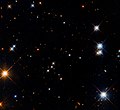File:Caldwell 96 (50327623248).jpg

Original file (1,519 × 1,388 pixels, file size: 720 KB, MIME type: image/jpeg)
Captions
Captions
Summary[edit]
| DescriptionCaldwell 96 (50327623248).jpg |
This image captures some of the shimmering stars in the outskirts of the open cluster Caldwell 96. Also known as NGC 2516 or the Southern Beehive (for its similarity to the Northern Hemisphere’s Beehive Cluster), this loosely bound swarm of stars was first recorded by the French astronomer Nicolas-Louis de Lacaille in 1751 from the Cape of Good Hope in Africa. It is a popular observing target for stargazers in the Southern Hemisphere. The cluster is located just over one thousand light-years from Earth in the constellation Carina and has an apparent magnitude of 3.8. Because it is so bright, Caldwell 96 is visible with the naked eye in dark skies. It appears as a hazy patch, but a pair of binoculars will resolve some of its roughly one hundred stars. Part of what makes Caldwell 96 such an appealing target for observers is its brightness, but it is also notable for hosting at least three double stars that can be visually separated with a small telescope. Double stars are pairs of individual stars that appear very close together from our vantage point here on Earth. This may be because the two stars in question are gravitationally bound, orbiting around a common point, or because two unrelated stars appear very close together by chance alignment but are really at different distances from Earth. The former category is also known as a binary star system, but the double stars in Caldwell 96 fall into the second category — what are known as “optical” double stars. Observers in the Southern Hemisphere can view the cluster and its double stars most easily during late summer. The above image of Caldwell 96 is comprised of observations taken by Hubble’s Wide Field and Planetary Camera 2 at ultraviolet, visible, and infrared wavelengths. These observations were part of a survey that took advantage of Hubble’s sensitive camera to learn more about the structures of distant galaxies and to understand the motion of star clusters. Credit: NASA, ESA, R. Griffiths (Carnegie Mellon University); S. Casertano (Space Telescope Science Institute), and J. MacKenty (Space Telescope Science Institute); Processing: Gladys Kober (NASA/Catholic University of America) For Hubble's Caldwell catalog website and information on how to find these objects in the night sky, visit: <a href="https://www.nasa.gov/content/goddard/hubble-s-caldwell-catalog" rel="noreferrer nofollow">www.nasa.gov/content/goddard/hubble-s-caldwell-catalog</a> |
| Date | |
| Source | Caldwell 96 |
| Author | NASA Hubble Space Telescope |
Licensing[edit]
- You are free:
- to share – to copy, distribute and transmit the work
- to remix – to adapt the work
- Under the following conditions:
- attribution – You must give appropriate credit, provide a link to the license, and indicate if changes were made. You may do so in any reasonable manner, but not in any way that suggests the licensor endorses you or your use.
| This image was originally posted to Flickr by NASA Hubble at https://flickr.com/photos/144614754@N02/50327623248. It was reviewed on 16 December 2020 by FlickreviewR 2 and was confirmed to be licensed under the terms of the cc-by-2.0. |
16 December 2020
File history
Click on a date/time to view the file as it appeared at that time.
| Date/Time | Thumbnail | Dimensions | User | Comment | |
|---|---|---|---|---|---|
| current | 17:44, 16 December 2020 |  | 1,519 × 1,388 (720 KB) | Szczureq (talk | contribs) | Transferred from Flickr via #flickr2commons |
You cannot overwrite this file.
File usage on Commons
There are no pages that use this file.
File usage on other wikis
The following other wikis use this file:
- Usage on pl.wikipedia.org
Metadata
This file contains additional information such as Exif metadata which may have been added by the digital camera, scanner, or software program used to create or digitize it. If the file has been modified from its original state, some details such as the timestamp may not fully reflect those of the original file. The timestamp is only as accurate as the clock in the camera, and it may be completely wrong.
| Orientation | Normal |
|---|---|
| Horizontal resolution | 72 dpi |
| Vertical resolution | 72 dpi |
| Software used | Adobe Photoshop 21.2 (Macintosh) |
| File change date and time | 19:05, 1 September 2020 |
| Y and C positioning | Centered |
| Exif version | 2.32 |
| Date and time of digitizing | 11:56, 13 February 2020 |
| Meaning of each component |
|
| Supported Flashpix version | 1 |
| Color space | sRGB |
| Bits per component |
|
| Compression scheme | Uncompressed |
| Height | 1,388 px |
| Width | 1,519 px |
| Pixel composition | RGB |
| Number of components | 3 |
| Date metadata was last modified | 15:05, 1 September 2020 |
| Unique ID of original document | xmp.did:5b5b3bc8-df40-4440-b2d7-bea8d21863b7 |